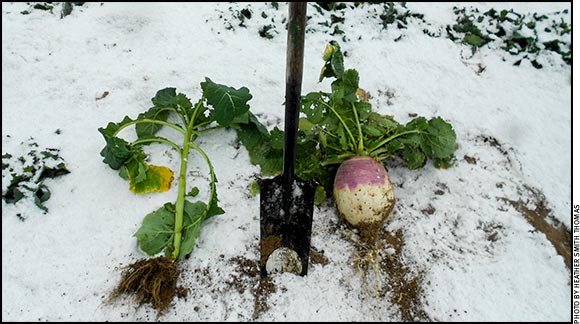HEALTH & NUTRITION...

Forage Turnips — A Great Way to Augment Pasture
Forage turnips provide an alternative crop and produce plenty of cattle feed during odd times of the year.
Sometimes nontraditional crops for livestock can augment forage supplies or increase production on a piece of land. Turnips are a good example. Cattle readily eat them and do well on turnips.
Tom Larson of Colorado farmed for many years in Nebraska, managing an organic crop and livestock farm, and experimenting with alternative crops and rotations.
He designed his system with many paddocks and moved cattle every two days.
“All I had was cool-season pasture and no warm-season grasses. To make up for the time in late summer when cool-season plants aren’t growing very well and there are no crop residues yet to utilize, I discovered that the biggest bang for the buck is turnips,” he said. Read more.
Behavior Patterns Indicators of Illness Onset in Cattle
AgriLife Research developing early warning system for bovine respiratory disease.
Texas A&M AgriLife Research scientists are developing an early warning system for pen riders or animal care providers to more efficiently identify and treat cattle for bovine respiratory disease (BRD).
Bill Pinchak in Vernon and Gordon Carstens in College Station, both AgriLife Research animal nutritionists, have been evaluating the relationships of animal behavior in confined animal feeding operations (CAFOs) to the onset of sickness.
Along with Texas A&M University students Will Kayser and Kirby Jackson, they recently summarized the results of more than four years of research in a paper, “Evaluation of statistical process control procedures to monitor feeding behavior patterns and detect onset of bovine respiratory disease in growing bulls.” Read more.
Foot Rot in Cattle
Severe lameness, inflammation and a foul smell usually indicate foot rot is the culprit.
Foot rot is an infectious condition that causes swelling, heat and inflammation, resulting in severe lameness. The swelling and lameness usually appear suddenly; One day the animal is fine, and the next day, the foot may be so sore the animal won’t put weight on it.
Andrew Niehaus, associate professor at the Ohio State University Veterinary Hospital, says foot-rot-causing bacteria are generally present in the environment. Animals living in an unsanitary environment where there is a lot of manure are most at risk.
“We tend to see more cases in wet, muddy conditions. Feet are constantly wet, which makes the skin softer; it becomes easier for pathogens to penetrate the skin barrier,” he says.
Any little nick, scrape or puncture around the hoof, heel or between the toes may open the way for opportunistic invaders. Read more.
3 Checks for Colony-forming Units in Silage Inoculants
Compare your inoculant label with this checklist.
Every time forage is ensiled, there is a microscopic war between “good” bacteria that can create high-quality silage and “bad” microbes that may cause spoilage. To help win this war, livestock producers need an army of elite lactic acid bacteria (LAB) from inoculants proven in independent trials to achieve the desired goals, says Bob Charley, forage products manager at Lallemand Animal Nutrition.
“Using a research-proven forage inoculant with the correct level of colony-forming units (CFUs) proven effective in trials helps ensure producers have enough ‘good’ bacteria to win the ensiling battles,” Charley says. “Microbes are very small and difficult to count directly, so CFUs are used.” Read more.
Large Animal Rescue Training for Emergency Response Teams
First responders, extension agents and veterinarians practice rescue situations at NMSU training.
The emergency call comes into the 911 center: A horse and its rider have fallen into a deep arroyo and the horse is lying on the person. Another call asks for help getting a horse out of a water-filled drainage ditch. A third call tells of a livestock trailer that has rolled over during a traffic accident.
These may seem like scenes from a television show, but they are real-life scenarios where emergency response personnel must be ready to respond.
Sarah Jucha of Bernalillo County, N.M., Animal Control said it’s not uncommon to get calls to rescue large animals.
“We get them all the time,” Jucha said. “I’ve had to get horses out of ditches. It can be tricky if you haven’t had training.” Read more.
PCR Testing Can Eliminate BVD Cycle
New research shows PCR’s higher sensitivity can reduce economic impact of false-negative results in infected calves.
New research was presented at the International Symposium of the World Association of Veterinary Laboratory Diagnosticians (WAVLD) June 7-10 in Sorrento, Italy, showing that using the right method for detection of bovine viral diarrhea virus (BVDV) virus in persistently infected (PI) calves plays an important role in eliminating the virus from the herd.
“PI calves look normal and act normal, so the only way to identify if a calf is a PI-BVD virus carrier is to test each calf,” said Gregg Hanzlicek, Kansas State University (K-State) Veterinary Diagnostic Laboratory. “Using an ear notch sample, PCR is the best tool to identify PI calves so farmers can remove them from the herd before breeding season starts.” Read more.
A Look at the Economics of Parasite Control
Research and real-life support the economic importance of controlling parasites in grazing cattle.
When cattle prices are lower and every input cost is scrutinized, it’s tempting to drop parasite control from the health program to save a little money. However, studies have shown a true economic benefit to controlling parasites.
“Parasite burdens in grazing cattle can decrease efficiency due to decreased appetites and utilization of feed that is readily available,” said Libby Fraser, veterinarian in Beef Technical Services at Zoetis. “When cattle are gathering their own feed, it is important for them to have healthy appetites. That good appetite can often be measured in end-of-grazing season weight gains.” Read more.
Cattle Diseases: Common Conditions/Terms
Click here for a list of common conditions and terms related to beef cattle diseases, such as anaplasmosis, brucellosis, BVD, E. coli, IBR and others.
[Click here to go to the top of the page.]






